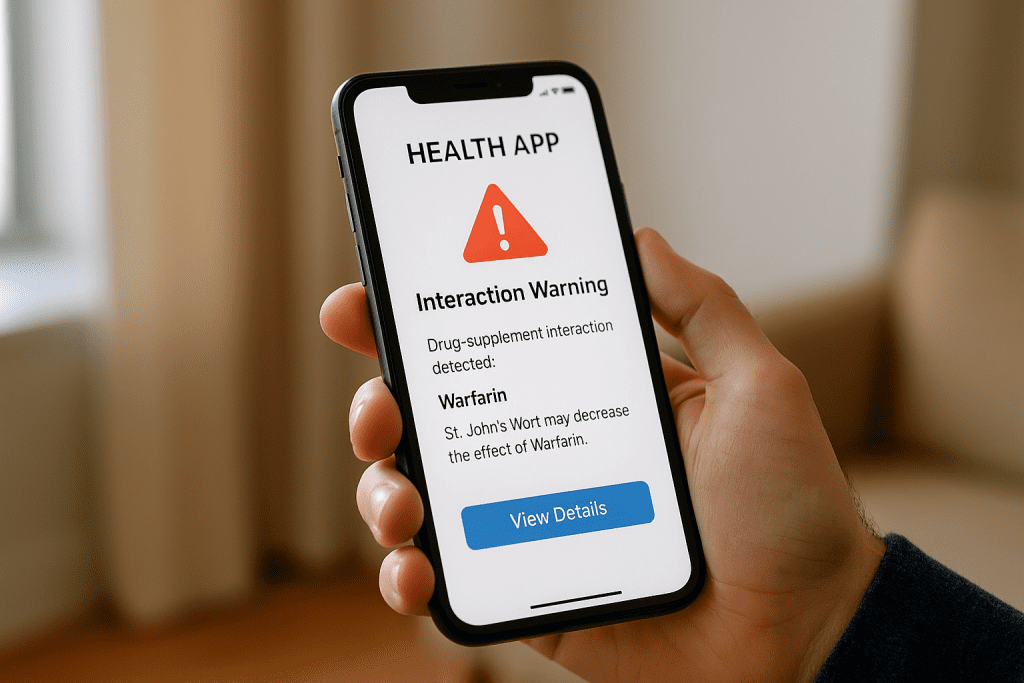If you’re using a supplement app to track potential drug interactions, accuracy is everything. That’s why many leading health apps rely on the DrugBank API—a highly structured, science-backed data source—to ensure interaction alerts are reliable and timely.
This article explores how the DrugBank API powers today’s most accurate drug-supplement interaction software, how to tell if your app is trustworthy, and which platforms are getting it right.
Summary / Quick Answer
Apps using the DrugBank API tend to offer more accurate drug-supplement interaction software because they rely on one of the most comprehensive pharmaceutical databases in the world. Here’s why that matters:
- ✅ Over 280,000 interactions, including supplements
- ✅ Regular updates from FDA, EMA, and Health Canada data
- ✅ Differentiates by severity and interaction type (e.g., metabolic vs. clinical)
- ✅ Integrated with top health apps and platforms
- ✅ Recognized as a trusted health app data source
When choosing a supplement interaction checker, look for API transparency, data update frequency, and scope of interaction coverage.
What Makes the DrugBank API a Reliable Health App Data Source?

DrugBank isn’t just another data provider. It’s a pharmaceutical knowledge base with clinical-grade data that’s accessible through a modern, RESTful API architecture. What does this mean for your supplement app?
- Comprehensive drug coverage: Over 4,900 drug entries and 200,000+ product listings across the US, Canada, and Europe.
- Rich interaction metadata: Severity ratings (minor, moderate, major), pharmacokinetic vs. pharmacodynamic tags, and clinical management suggestions.
- Structured endpoints: Designed for smooth integration with mobile health apps and electronic health records.
- Reliable authentication: API keys and time-limited tokens ensure secure, controlled access.
Think of it like this: using an app without DrugBank is like flying without GPS. You might get where you’re going, but you won’t know what you’re flying over—or into.
| Feature | DrugBank API |
|---|---|
| Source updates | Daily |
| Interaction entries | 280,000+ |
| Supplement data | Included |
| API format | RESTful (JSON) |
| Coverage | FDA, EMA, Health Canada |
Real-World Apps Using the DrugBank API
GenXys TreatGx: Personalized Medication Plans
GenXys’s TreatGx platform offers personalized prescribing by combining pharmacogenetics with DrugBank’s interaction engine. Based on genetic testing and patient history, it flags dangerous combinations, adjusts dosages, and even highlights supplement-related risks. This level of personalization wouldn’t be possible without DrugBank’s detailed, multilayered dataset.
Thrive Health: Smarter Telehealth
Canada-based Thrive Health integrates DrugBank’s API to power remote consultations with accurate drug interaction checks. The app uses autocomplete tools and robust search filters to verify medication lists, even when access to a pharmacist is limited. This is especially valuable in telehealth, where clarity and speed are non-negotiable.
Synkwise: Residential Medication Management
For residential care providers, Synkwise uses DrugBank data to streamline medication safety. One standout feature: offline lookup of medication interactions—a lifesaver in areas with weak internet access. Its ability to match drug formulations by dose, route, and form highlights the API’s depth.
Curious how consumer apps compare? Check out this evaluation: “MyNetDiary vs. manual interaction tracking”.
How DrugBank Improves Supplement-Drug Interaction Accuracy
Not all apps treat supplement interactions seriously, but DrugBank does. By maintaining entries like Vitamin E and Calcium, the platform allows software to analyze how common vitamins interact with prescriptions.
For example:
- Calcium can interfere with the absorption of antibiotics.
- Vitamin E may increase the risk of bleeding when combined with blood thinners.
Each entry includes interaction type, severity, clinical notes, and references. Apps using DrugBank can translate this into helpful user alerts—often specifying whether a supplement should be spaced hours apart from a drug or avoided entirely.
Common Interactions Flagged by DrugBank:
| Supplement | Example Drug | Interaction Risk |
|---|---|---|
| Calcium | Ciprofloxacin | Reduces drug absorption |
| Vitamin K | Warfarin | Decreases drug effect |
| Magnesium | Levothyroxine | Impairs absorption |
| 5-HTP | SSRIs | Risk of serotonin syndrome |
If your app can’t do this level of filtering, it might be time to switch.
Key Features That Set DrugBank-Backed Apps Apart
To evaluate the accuracy of drug-supplement interaction software, ask these questions:
- What’s the source of the data? Is it DrugBank or an unvetted third-party list?
- Does severity grade interactions? Minor vs. moderate vs. major matters.
- Does it support multiple input formats? NDC codes, product IDs, and brand names.
- Is supplement data included and updated regularly?
Apps backed by DrugBank tend to score high on all of these. For developers, the API supports:
- Custom search filtering by drug class, indication, or even off-label use
- Structured warnings based on demographics (age, pregnancy, comorbidities)
- Therapeutic alternatives, useful when a safer option is available
And for consumers? It means fewer surprises, safer supplement stacks, and more informed choices.
Limitations to Be Aware Of
No API is perfect, and DrugBank is no exception. While its coverage is vast, it’s still limited to documented interactions. That means:
- New supplements may not yet be listed
- Rare or emerging interactions might be missed
- Not every app uses the latest version of the API
That’s why it’s important to use apps that disclose their data source and update schedule. Transparency builds trust.
Conclusion
An app using the DrugBank API for supplement interaction checks isn’t just technically impressive—it’s a smart choice for your health. Whether you’re managing chronic conditions or just looking to take the right vitamins, accuracy matters. Trusted platforms like TreatGx, Thrive Health, and Synkwise show what’s possible when clinical data meets good design.
For more on finding accurate supplement tools, see our related article: “MyNetDiary vs. manual interaction tracking”.
